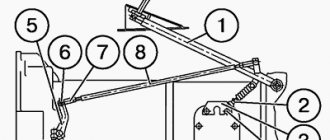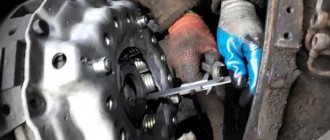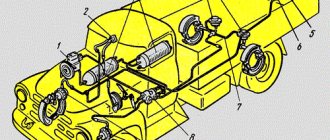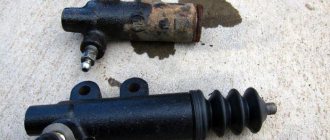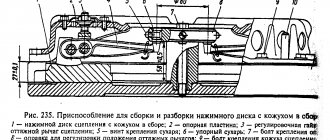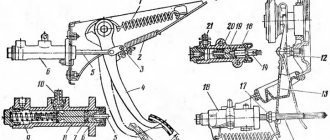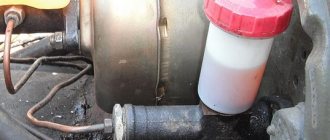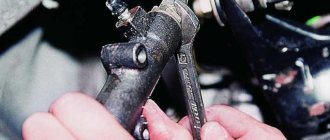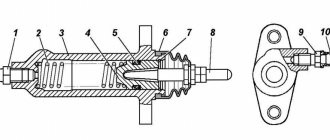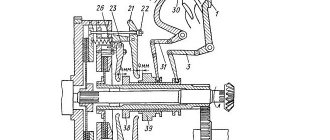The vehicle's clutch serves to smoothly connect the engine crankshaft to the gearbox shaft in order to transmit torque further through the transmission to the wheels. Why is there a need for such a smooth connection? — The fact is that the engine, which is the source of movement and torque for the car, has a certain rotation speed. And this engine speed is much higher than that needed to rotate the wheels. This means you need to lower the speed in the engine-wheel connection. A gearbox (gearbox) is used for this purpose. But in order to smoothly connect the gearbox to the engine, or vice versa, to completely disconnect the gearbox from the engine, a clutch is used.
The principle of adjusting the clutch of UAZ 3303
UAZ cars have been popular in Russia for decades.
They have always been distinguished by high maneuverability, reliability and good control quality. The UAZ model range is constantly expanding, developing and improving. Everyone knows that cars are assembled from several thousand parts, and when the car is in use, it may be necessary to replace any, perhaps even the smallest part, which nevertheless plays a very large role in the life of the car. There is an opinion that the clutch is one of the most vulnerable points in a UAZ car. The real cause of the problem is that the clutch of the UAZ 3303 and other cars of this series is adjusted incorrectly. Very often, the maintenance of the mechanism is not given enough attention and its importance is not realized. With proper and timely care of the diaphragm clutch installed on the car, it will work perfectly for a long period of time, at least five years exactly, and even with rather merciless operation.
Let's sum it up
To summarize, it is important to note that adjusting the designated mechanism is a fairly important factor for the long-term and proper operation of the off-road Patriot. Remember that tuning is always required after replacing any component of the clutch system, as well as when the car drives 20-30 thousand km. km. Adjustment is quick, easy, and requires a minimum of tools. The most important thing is to carefully study the adjustment process and understand its principle.
The principle of operation of the UAZ clutch
The main elements of the clutch, as is known, are:
- crankcase;
- release clutches;
- drive disk;
- driven disk.
One of the most important elements on which the reliability of the mechanism mainly depends is the master cylinder of the UAZ 3303 clutch. But we should not forget about the working cylinder, which plays a very important role. The cylinders are connected using a hose and tube.
The diaphragm spring, from which the entire design gets its name, is located in the drive disc housing. The support rings and pressure plate are also installed here. The spring is secured in such a way that its edges can have a strong influence on the pressure plate.
The structure of this system provides that the driven disk can come very close to the engine flywheel and even come into contact with it, and also transmit torque to the driven disk using friction linings. After this, the torque is transmitted to the gearbox. If it is necessary to temporarily disconnect the engine from the transmission, the UAZ 469 clutch release drive is used.
When you press the clutch pedal of the UAZ 469, the piston of the master cylinder begins to move forward. Because of this, the liquid is displaced and enters the working cylinder. After which she extends the piston with the rod. This rod acts on the shank of the fork, as a result of which it begins to turn and moves the release clutch. Thus, the ends of the petals of the diaphragm spring are pressed, the action of the spring on the pressure disk ends, and the supply of torque also stops.
Types of friction linings
Organic - Friction material that is used on 95% of all types of clutches used today. Organic overlays are cheap and unpretentious. It is for these reasons that they are used by automobile manufacturers for cars aimed at comfortable everyday use. Many tuning brands of clutches have enhanced organics in their line, which differs from the factory ones in the higher quality components of the friction material, the heat resistance of which does not exceed 250°C. But these clutches can be called reinforced not so much because of a higher quality composition, but rather because the kit includes a basket with increased downforce.
FiberTuff is a new innovative friction material that features a blend of ceramic filler, carbon fiber and Kevlar, designed to be a wear-resistant, high-strength, high-temperature resistant alternative to organic linings. In terms of frictional properties, FiberTuff linings are very similar to organic linings. But they can withstand 10-15% more torque than organics (without increasing downforce). The service life of this composition is 2-4 times longer than organic. Heat resistance increased to 400°C. When using this clutch, there is an improvement in the clarity of clutch engagement.
Kevlar - friction linings made of Kevlar fiber - a polymer material that came to the automotive industry from the aerospace industry. Kevlar is also used to make bulletproof vests and the bodies of supercars like the Ferrari Enzo - parts that are very strong and very light. Kevlar clutches have a wear resistance that is 5-10 times greater than organic linings. They have increased heat resistance and do not wear out the working surfaces of flywheels and pressure disks. But during installation they require proper installation - the linings are very sensitive to cleanliness and quality of installation, and then a delicate running-in is required for at least 1000 km. The heat resistance of Kevlar linings reaches 370°C. A clutch disc with such linings is well suited for long-term hard use of the machine.
Metal ceramics come in different types: aluminum, cast iron, copper. Most manufactured clutches use metal-ceramic linings made on a copper base. Clutch discs with these linings have a high coefficient of friction and can withstand very high temperatures (up to 600°C). They are very popular in motorsport and tuning, since with equal disc sizes the transmitted torque can double. The disadvantage of such linings is their aggressiveness towards mating parts. They wear out the friction surfaces of the flywheel and basket pressure plate relatively quickly. Therefore, they are recommended for use only on sports and racing cars.
Carbon - clutches based on carbon composites. The main feature is that the pressure and driven disks, as well as the mating surface of the flywheel, are made of carbon. It provides the necessary coefficient of friction (since the coefficient of friction of carbon on cast iron is very low) and maximum wear resistance. This mechanism has an incredible temperature limit (2500°C). Durability is 5 times higher than “organic”. The only drawback is the high cost.
In detail from the old classics. Much Posted: Makhno, May 21, 2000 2:59:59 PM
So, about repairing the clutch basket. I promised to write for a long time, but it didn’t work out, all sorts of things got stuck, NOT automobile ones, and to such an extent that I haven’t been able to start assembling a new engine for the second month. Well, okay, it will be in time. Now listen to another Father’s fairy tale.
DON'T THROW AWAY, SON, OLD SPARE PARTS, ESPECIALLY THE BASKETS FROM THE 21st VOLGA. DO NOT NEED LUBRICANT YET, WRAP IN A RAG, AND PLACE IN A DRY PLACE. MAYBE THEY WILL BE USEFUL.
On the eve of the above-mentioned assembly of a new engine, we had to face the following phenomenon, which, however, was completely PROGRAMMED by the entire course of OUR history, namely: THE QUALITY OF SPARE PARTS. It looked like this. I had several baskets from the 21st and UAZ, different years of production, from the 50s to the present time. Everything is used, obviously, but with intact casings and very decent pressure plates, even, without c.l. traces of work on rivets. And the only bad thing about them, at first, experienced glance, was the condition of the axles-legs-fungi: on the axles and in the holes of the legs there were traces of needles and rollers, and the fungi, of course, were fairly damaged by the release bearings. Along the way, I noted (and at one time told the respected Confe my observations) that the QUALITY OF ALL PARTS IS PROPORTIONAL TO THEIR AGE - the older their age, the greater (higher) their quality, the cleaner they are made and the higher the quality of their material. But, being a Russian person (this is not nationality, but a way of life + fate), and, of course, harboring well-known (and ineradicable in all of us) illusions, and being weighed down financially (well, really, what’s the point of buying two new baskets, if it is ENTIRELY POSSIBLE to repair the 4 available), I took 200 rubles and went to the store. And I bought (well, to think a little about my own observations!) 2 sets of these same parts. I brought them home, put them in a separate box, then all sorts of worries piled up and I only picked them up about 2 weeks later (too late to change them!). When I looked at them CAREFULLY, I realized that the surname of my direct ancestor in the first generation (I bear my mother’s surname) does not mean anything - I am RUSSIAN 10,000 times. ALL the parts were made from the material that should be used to make NAILS; they were perfectly processed with a file, and the bearing surfaces of the holes in the legs, which should be smooth and shiny, were made with a blunt drill with a diameter exactly 0.5 mm larger than required . Putting such parts on your beloved Mashenka would be a MULTIPLE crime both against her and against yourself, especially since a multi-year long-term program was planned for the engine, namely balancing a new, stuffing box CV WITH TWO BASKETS. Having understood EVERYTHING about myself, and deciding that spending could not be avoided, I went back to the shops. But now I was already smart - I took a small needle file with me. I come, ask to see the basket, turn it over in my hands and discreetly try its details with a file. One store, a second, a fifth. TIRED! ALL BASKETS ARE MADE FROM St3. . ALL THEIR DETAILS. After 5-10 thousand km. run, such baskets will have to be thrown into the hazel tree or repaired from the same perspective, wasting energy and nerves and KNOCKING OFF THE BALANCE. This means that the problem cannot be solved with money. I come home, clean the workbench, lay out what I have, and look carefully. The UAZ basket from 1995 is a little better than the ones I saw in stores, but the same thing, and the protrusions of the pressure plate, designed to fit in the slots of the casing, are a little low and have cut through these very slots with their cast-quality edges TO THE TRASH! There are 3 baskets left from the 21st Volga. But their internal diameter of the pressure plate is 5 mm smaller than that of the UAZ; our driven disk is not included! Okay, we can sharpen it, it’s not a hindrance for us, especially since it’s all the same - balancing. Let's look further. The axles and tabs are made of GOOD metal, a file will not take them (as well as pressure plates!). Well, there are, of course, traces of indentation of the needles and roller, but, on the other hand, they can be regarded as the maximum possible deformation. The contact areas have increased MANY TIMES, and are unlikely to increase further, especially since I have not disassembled anything - every detail is marked, and will continue to work IN ITS PLACE with old friends. I rummaged around in the bins and found a handful of old-fashioned, untrodden fungi - a file won’t take them either. FINE. BUT THE TOTAL DEFORMATION of the entire system of legs is about 1 mm. When assembling the basket, this leads to the fact that the fungal end of the foot moves towards the flywheel by approximately 5-7 mm and, in order to maintain the standard size from the top of the fungus to the plane of the flywheel, the fungus will have to be strongly turned out of the foot. And the fungus is a tricky detail: if you turn it out a little more, its locking slot will go inside the threaded hole in the foot; you won’t be able to lock it! And vice versa - if you screw it in almost all the way, the bottom of the slot will come out of the thread again and you won’t be able to lock it! And it is NECESSARY to maintain the mentioned size, otherwise the geometry of all the levers and the foot itself, and, most importantly, the release bearing fork, will greatly change, which will lead to an increase in the force on the pedal and its travel.
Adjusting mechanisms
Parameters after adjustment
It is generally accepted that correct adjustment of the clutch can ensure its greatest reliability . First, you need to measure the amount of free play at the drive pedal, which disengages the clutch. If the clutch has a diaphragm spring, then the recommended value should be in the range from 5 to 30 mm. After pressing the pedal all the way, it is necessary to measure its full stroke, the recommended value of which should be approximately 16.5 centimeters. This size can be determined using an ordinary ruler.
If it is necessary to change the position of the pedal, we adjust the length of the pusher, which is located in the master cylinder. This adjustment is carried out as follows: unscrew the lock nut with a wrench, begin to rotate the rods, using pliers. This way, the desired pedal position is established, which will be more convenient. Ideally, a 13 key can be used for this operation.
It should be noted that the clutch with a diaphragm spring does not need to adjust the release mechanism, since the spring itself can provide optimal values. In other words, adjusting the clutch of the UAZ 469, UAZ loaf and UAZ Patriot will not be difficult. Clutch baskets can be purchased at specialized stores.
Adjusting the pedals
For correct operation of the clutch, periodically measure the pedal stroke and, if necessary, set the required values.
Incorrect adjustment can cause problems such as:
- Disc slipping. Incomplete pressing occurs due to the lack of free movement of the pedal.
- The clutch “drives” (incomplete disengagement). It is difficult to change gears. Because of this, rapid wear of the rings and failure of synchronizers occurs.
Problems with the clutch operation of a Patriot SUV can lead to serious consequences.
Measuring full pedal travel
The pedal height is the distance from the pad to the cabin floor. For UAZ produced before 2007, the value should be 13-15 cm, and for UAZ Patriot 2007 and later - 120-140 mm. If the measurement result does not correspond to the set range, the pedal position must be adjusted.
Changing the length of the pusher
To adjust, you need to do the following:
- Loosen the clutch switch sensor (adjusting bolt) and turn it so that it does not touch the pedal.
- Loosen the pusher locknut and rotate to set the required value, then fix the rod.
- Install the sensor so that it touches the pedal, and then tighten it 3/4 of a turn.
After adjustment, re-measure the set length of the master cylinder pusher.
Maintenance
Get regular maintenance
To service the clutch basket of UAZ vehicles with a diaphragm spring, professional skills are not required. First of all, the clutch must be kept clean, regularly removing any dirt that has arisen. Bolted connections need to be tightened periodically.
It is necessary to constantly check the volume of working fluid that is in the master cylinder. It should be about 1.5 centimeters, but below the top edge of the cylinder. In this case, the tank is filled using the installed mesh filter. It is used to prevent the entry of unnecessary objects and substances. Typically, the UAZ 469 clutch slave cylinder does not require any additional, special manipulations.
Removing air from the drive hydraulic system
Quite rarely, but it happens that the clutch needs bleeding. This can be understood from the fact that it does not turn off completely and the pedal is not pressed so softly. Bleeding is the removal of air from the hydraulic system. This process is carried out when the liquid in the tank is at a normal level.
During work, it is necessary to remove the rubber cap located on the bypass valve and install a hose in this place. Then the other end of the hose is lowered into a 0.5 liter container containing brake fluid in a ratio of 1:3.
Afterwards, the bypass valve must be turned one turn while another person presses the pedal all the way. You need to press the pedal until the air bubbles stop being released. The bypass valve must then be tightly closed.
Some UAZ owners may recommend tightening the bypass valve after each pedal press. This will help to significantly increase the pumping speed and achieve complete neutralization of air. Usually the air disappears from the system after the third or fourth repetition of the operation.
UAZ cars are very reliable. It doesn't take much effort to fix clutch related problems. You can carry out all the work yourself or contact a technical service. Clutch repair or adjustment is not an expensive service. As the owner of one of the UAZ series of cars, you need to carry out timely and constant care of the car, since an unscrupulous attitude can lead to severe pollution and lead to a number of difficult-to-solve problems.
Source
Design features and operating principle
A mechanical clutch does its job using frictional . The hydraulic type of connection between the motor shaft and the gearbox shaft occurs due to fluid . The electromagnetic type works due to a magnetic field.
The electromagnetic type of clutch can be understood from the operating principle of the electric fan coupling.
The hydraulic clutch type is most often used in conjunction with automatic transmissions.
the mechanical type of clutch below.
The principle of operation of the clutch on the UAZ loaf
By pressing the pedal, the driver acts on the fluid in the line. The fluid transfers pressure from the master cylinder piston to the slave cylinder piston. The master cylinder moves the fork piston.
The release fork presses against the release bearing, which transmits force to the clutch mechanism, which disengages the transmission from the transmission.
By releasing the pedal, the driver returns the entire mechanism to its original state. Under the action of the return spring, all elements involved in the process of disengaging the clutch assume their normal positions, this is how the UAZ loaf clutch works
Operation of the GVC
Below is a brief description of how the clutch works:
- When you press the clutch pedal, the pusher moves the piston and the compensation hole closes.
- It pushes fluid in front of it into the system, creating pressure.
- This pressure acts on the piston of the working cylinder, which pushes the rocker arm through the rod.
- The fork, moving the release bearing, acts on the crankcase petals, releasing the pressure plate from the clutch disc.
The valve and disc play an important role in the pumping process. Even if the system is not primed, it will still fill up. Simply unscrew the master cylinder valve and allow the fluid to flow through it. It fills the system by gravity, the same applies to the brakes.
The liquid enters through the expansion port into the cavity in front of the piston through the valve into the line. When filling is complete, the liquid flows out through the valve. The most important thing is that the piston rod should not be extended, and the expansion hole should not be blocked by the handle.
When pumping, everything happens a little differently.
- When the piston moves forward, valve 19 is open.
- When moving backwards, the valve is closed and the front valve creates a vacuum.
- There are holes in the piston that are closed by plate 3. It retracts and opens the holes. Liquid flows from the space above the piston and reservoir through the bypass hole into the space in front of the piston, which is under pressure. The collar (cork) allows it to overflow.
- When the lock ring is reached, the piston stops and the spring compresses the plunger and plate. It's ready for a new cycle.
Clutch design of the most common UAZ models
The entire clutch system UAZ loaf
First, let's define the term "clutch". It is necessary for smooth connection and disconnection of the crankshaft with the vehicle transmission. This is necessary when changing the driving mode (changing gears in the transmission) or stopping the car. The UAZ 469 military jeep was equipped with a dry single-plate clutch, a very popular system in the automotive world at that time. This coupling consisted of the following components:
- pressure disk in the housing;
- special pressure springs and clutch release levers;
- friction disc equipped with friction linings.
Clutch malfunction UAZ loaf
The main malfunction of the GTZ is damaged flanges. If the “mushroom” is faulty, the piston will not create pressure in the system, and the UAZ loaf clutch will stop compressing. It usually has nicks, cracks, or is simply worn out. Frequent, repeated clicks will, of course, help, but not for long. You can't rush and get stuck. You need to replace the cuff or replace the main cuff entirely.
In the second option, if the second ring is damaged, the liquid will leak out. DOT will drip onto the cabin floor. It is quite possible to replace the ring from the repair kit.
Frequent malfunctions and their causes
The clutch system of a UAZ car is characterized by various violations: the reinforced clutch of the UAZ is a loaf, the mechanism does not squeeze out, slips or does not pump. Timely maintenance, replacement of worn parts, lubrication and monitoring of the fluid level in the tank, diagnostics of all systems and mechanism components allows you to avoid such problems.
Clutch repair UAZ loaf
Having a diagram of the internal structure allows you to carry out repairs yourself in case of simple defects. Increased fuel and oil consumption, coolant leakage, unusual noises and knocking in the mechanism are the first signs of the need for repairs. Maintenance and replacement of worn parts help extend the life of parts and vehicles.
How to adjust the clutch pads
To adjust the UAZ loaf clutch, the following repair work must be performed:
- Using a ruler, measure the free radius of movement of the drive pedal that disables the mechanism. The standard value for the spring type should be in the range from 35 to 55 mm, for the membrane type - from 5 to 30 mm.
- Measuring the full travel of the pedal when it is lowered all the way. The standard value for the lever-spring type is 18.5 cm, for the membrane type - 16.5 cm.
- Set the desired position by changing it using the key.
- Check the distance with the pedal down between the engine block bulkhead and the center of the rod shaft. The value of 9.6 cm must be achieved. The fork free play must be at least 1.7 cm. Changing the length of the work basket bias rod is an adjustment tool. To do this, remove and reinsert the pusher until the desired value is reached.
We adjust the clutch on the Patriot with our own hands
Currently, it is quite easy to get to a service station, where professionals in their field will determine the causes of the malfunction, and also eliminate all problems in the car, however, not every car owner is willing to pay a lot of money for absolutely simple work that can be done independently, especially such work , like actually adjusting the clutch pedal on the popular domestic UAZ Patriot. We invite you to consider in what sequence and how to adjust the clutch correctly.
- To begin making adjustments, be sure to measure the length of the current pedal stroke.
- Then we measure its full stroke, which is always equal to 15 cm ± 2 cm.
- How to change pedal stroke length? You will need to adjust the pushrod length on the adjustable master cylinder.
- Adjusting the length of the pusher. This is done by unscrewing the locknut, plus you need to rotate the adjusting nut directly along the rod. For this purpose, you will need a 10mm wrench. Next in the photo we suggest looking at what the adjusting nut 1, a device such as a pusher and an eye look like.
- After you have obtained the desired result, tighten the locknut carefully but completely, do not forget to connect the pusher to the pedal and experimentally check the result you have achieved.
When you are sure that the full stroke is the correct value, safely consider that the adjustment was made successfully.
The clutch mechanism in the Patriot always requires careful and attentive treatment. Do not allow contamination or any minor defects in the mechanism. When signs of a malfunction begin to appear, it is not recommended to operate the car, because this will lead to faster wear of the unit, and it can all end in a breakdown along the way and expensive repairs.
Below is a video that will help you visually examine the process of adjusting the clutch on a UAZ Patriot, which has a 409 engine installed.
Replacing the clutch of a UAZ loaf with your own hands
First, drain any remaining fluid in the system. This can be done using a syringe. This operation is necessary in order to flush the hydraulic cylinder system from contaminants. On some models, access may be limited by the cooling system expansion tank. For convenience, loosen the nuts holding the tank and remove the hose. It should be unscrewed with a 10 mm wrench. Next, remove the metal tube coming from the clutch master cylinder. It could be copper or aluminum. Then remove the master cylinder by unscrewing the two mounting nuts with a 13mm wrench. You must use a 17mm socket to remove the hose coming out of the slave cylinder. Then we will need a 13mm wrench again.
Use it to unscrew the two bolts securing the clutch cylinder. The UAZ is in neutral gear at this time. The working cylinder itself in this car is installed on the gearbox housing. Carefully remove the pushrod from the fork to avoid damaging other components. If the hoses are removed “on the fly”. (i.e. with the component removed), the cylinder can be secured on one side with an adjustable wrench, and the tube can be unscrewed on the other side using a spanner. However, be careful, as the rubber may break under mechanical stress.
Need for adjustment
Adjusting the pitch of the cone in the clutch cylinder is done to ensure that the clutch performs its task correctly. If configured incorrectly, two types of interference may occur.
Free play adjustment
This is the distance the pedal can be moved without encountering resistance and without causing the clutch to engage or disengage. The free wheel is adjusted after replacing the mechanism or when the discs are worn. The clutch release drive consists of a working drive and a release bearing fork. The release mechanism housing is located on the bell body and is secured with two bolts. The pusher and rocker arm are located inside the housing.
The free wheel is adjusted by changing the length of the rod with the cylinder removed.
To adjust, follow these steps:
- Dismantle the clutch cylinder and remove the pusher;
- Loosen the lock nut and unscrew (tighten) the piston rod no more than 5 mm;
- Reinstall the pusher and assemble the control center.
Since the adjustment unit is not visible from the outside, if the adjustment is incorrect, the slave cylinder must be disassembled again.
Types of clutch
There are several types of clutch: mechanical (friction), electric, hydraulic, and their combinations. All clutches are similar in operating principle; in fact, they are mechanical with various modifications that meet the specified conditions of comfort and operation. Structurally, the clutch consists of several elements, the combination of which determines the type of clutch:
- single and double flow. On passenger cars, a single-flow clutch is used. double-flow is used on tractors and special equipment to rotate the power take-off shaft;
- by friction: wet (in oil) and dry (in air);
- permanently closed (used on passenger cars) and non-permanently closed;
- by the number of available slave disks: 1-disk (the most common), 2-disk and multi-disk.
- depending on what kind of springs are used, there can be the following types: with a diaphragm (in the center) spring and with cylindrical (circumferential) springs.
Currently, the most common type of clutch found on cars is a single-plate dry type clutch.
